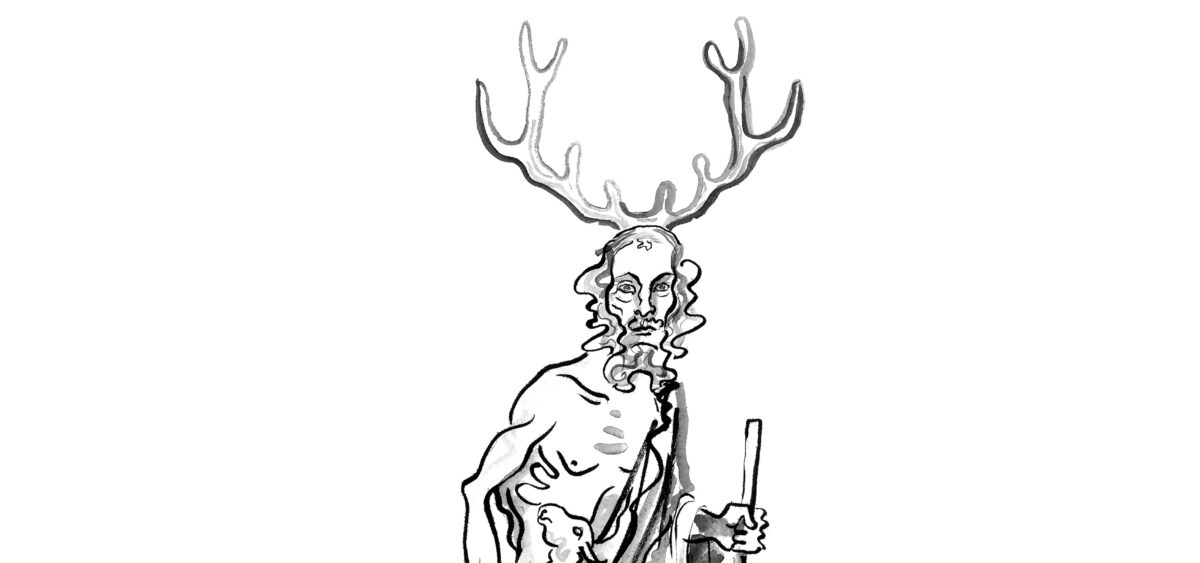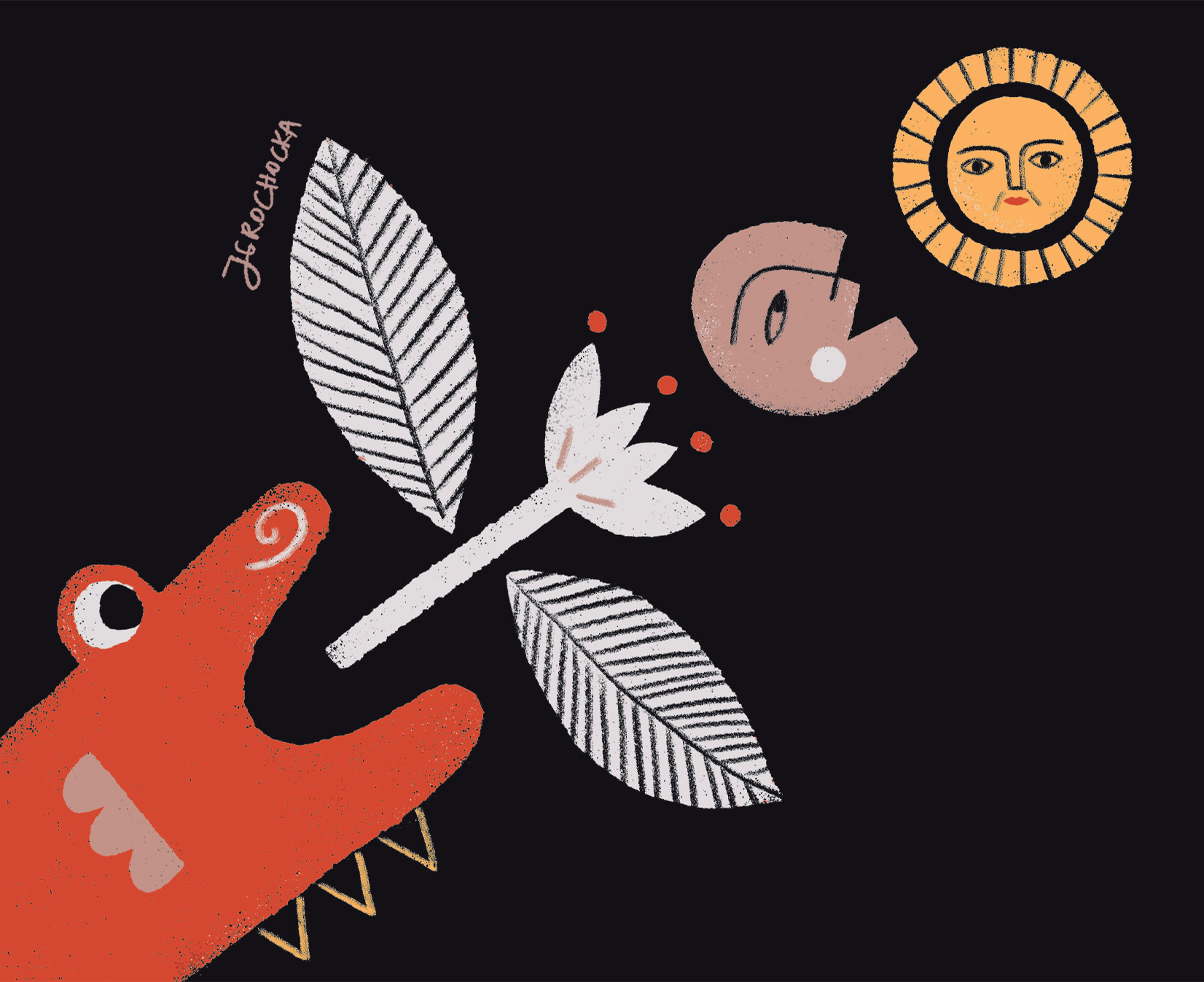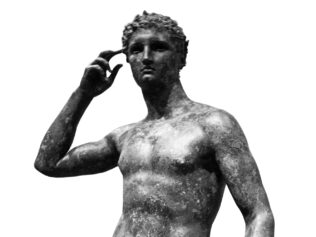
Pythagoras, who formulated the famous mathematical equation, practised fortune-telling, Epimenides of Crete was a soothsayer, while the philosopher Empedocles could supposedly resurrect the dead. Does this mean that ancient Greece had its own shamans?
The term ‘shaman’ comes from the Tungusic word samān, in turn derived from the verb sa (‘to know’). Strictly speaking, shamanism is a religion of the Siberian peoples. Its ‘discovery’ and description by Western scholars (including the exceptional Polish researcher Maria Czaplicka, who is little known in her own country) led to the reinterpretation of many cultural texts and phenomena, beginning with prehistoric cave paintings and ending with European ‘paganism’ or folklore.
Some argue that shamanism is one of the oldest forms of religion, existing at least since the Upper Palaeolithic. Perhaps the famous cave paintings in Lascaux, Trois Frères or Altamira are depictions of shamanistic trance. Among other things, they present human figures wielding staves and wearing animal furs. Birds are emerging from their bodies, possibly symbolizing the soul. Some of the men have visible erections, which also confirms their having entered a state of ecstasy.
Shamanism was culturally important in hunter-gatherer and nomadic-pastoral communities, but it must have begun to fade as these groups started to disappear. Although the peoples of Central and North Asia were subject to Eastern influences, they nevertheless preserved shamanism in a ‘pure’ form, although it is not dominant there and coexists alongside other forms of cult. Still, it is in this region that shamanism has enjoyed particular reverence, thanks to which its unique practices and rituals have survived to this day.
Owing to brilliant studies such as Shamanism: Archaic Techniques of Ecstasy by Mircea Eliade, we know that such practices were common across various religions and areas. This has in turn sparked an endless debate about whether shamanism is universal, emerging independently and spontaneously in different cultures due to its psychobiological origins, or historical, spreading thanks to intercultural exchanges.
After decades of enquiry, shamanism finally ceased to be marginalized (it used to be regarded at best as a subject suitable for psychopathology, while earlier it was simply deemed a form of satanic possession) and became crucial for the Western understanding of not only the history of religion, but also the history of ideas.
Traces of shamanism can be also discerned in European culture. Comparison of practices and beliefs characteristic for Siberian shamanism with elements of Greek culture yields surprising results. We may infer that the shamanistic tradition was known to ancient Greeks, even to some of the most prominent thinkers, as is argued by the outstanding classical philologist Eric R. Dodds. There is also reason to believe that certain Greek philosophical ideas, which we have inherited, are actually rooted in shamanism.
In the snows of Siberia
Before turning to the Greeks, however, let us recall what characterizes shamans from Siberia. Although shamanism was greatly diversified even in its cradle, we may attempt to outline its central tenets.
Every shaman is a magician, but not every magician is a shaman. As Eliade famously argued, shamanism is an “archaic technique of ecstasy.” What distinguishes shamans from other ‘authorities on the sacred’ is the ability to enter a state of ecstasy thanks to certain ritual practices. Vital to this system of beliefs, ecstasy or trance can be achieved through dancing, drumming, singing or using psychoactive substances. This experience involves journeying into the spirit world in the form of a ‘flight’. Behind this idea lies a specific cosmology that encompasses a parallel reality of spirits and demons, heaven and hell. Still, whenever shamans venture into the netherworld, they do so for important reasons: to save the soul of a sick person (by appeasing spirits or fighting them) or to escort the dead. Shamans are healers and exorcists in the sense that they consider sickness to be caused by the loss of one’s soul. Basic shamanistic skills include communicating with the spirit world. Thanks to their secret knowledge, shamans are able to discern reality’s hidden dimensions and foretell the future.
Shamans may be elected, but the most powerful ones are those who have inherited their status or achieved it instinctively. Sometimes they would stand out already since childhood due to some physical defect or a predilection for reclusiveness. Sooner or later, they would undergo painful initiation when struck down with ‘shaman sickness’ (earlier classified as a mental condition akin to hysteria, schizophrenia or epilepsy), usually facing it alone. Let us immediately add that treating shamans as mentally ill is now completely groundless, since they would keep themselves busy with matters of everyday life, earning a living and often exhibiting an exceptional degree of control over their minds and bodies. Besides, if shamans were to be regarded as out of their minds, they would lose their authority in the community.
Shamans acquire their unique skills mainly by suffering pain that is unfathomable to the uninitiated. When one goes down with ‘shaman sickness’ – understood as the calling of the spirits – there is no turning back. Those who have been through this process argue that “had I not become a shaman, I would have died.” They compare the experience to death, after which one is reborn as a ‘wounded healer’ – a term developed by Joan Halifax to refer to those undergoing such a transformation. Self-recovery allows shamans to gain control over the spirit world and consequently help others. This is what constitutes the crucial difference between possession and shamanistic trance: in the case of the former, one loses all control, whereas in the latter situation, shamans actually reassert their mastery and greatness.
In shamanistic initiation, an important role is played by teachings received from older shamans, who not only help the candidate to understand the world of spirits by learning their names and characteristics, but also provide instruction regarding specific shamanistic techniques and a holy secret language. Apart from healing and exorcising, shamans can also attempt to control the natural elements, make sacrifices and perform duties similar to those of a priest. Knowledge of holy incantations alongside the names of spirits and their histories also makes shamans assume – when necessary – the function of storyteller or poet.
Three Greek sages
The above general account facilitates making a comparison that takes us from the remote and cold Siberia to the Mediterranean, where Epimenides of Crete lived at the turn of the seventh and sixth century BCE. Today, he is regarded as one of the legendary ‘seven sages of Greece’. Epimenides supposedly acquired vast knowledge after being initiated into an orgiastic cult of Zeus and spending many years isolated in a holy cave. During this period he established intense communication with spirits of darkness, underwent ascetic training, and entered intense, long-lasting ecstasy. When he learned to control this state, he returned to his community, where unique insight allowed him to foresee the future and cure those possessed by demons. In The Constitution of the Athenians, Aristotle mentions that at the beginning of the sixth century BCE, Epimenides released Athens from a curse, thereby clearing the city of the dishonour brought about by killing the would-be tyrant Cylon and his followers at the altar steps. Epimenides allegedly made appropriate sacrifices, appeasing the souls of the victims and underground spirits. These practices bear a striking resemblance to shamanism. Moreover, according to Diogenes Laërtius, Epimenides would refrain from sleeping and “spend the best part of the night looking for various roots.” Were they ingredients of ecstasy-inducing potions?
Let us now consider Empedocles of Akragas, author of the philosophical poem “On Nature”. It turns out that this thinker, active in the fifth century BCE, not only offered insight into the four elements that make up all matter, but also held that he could stop the wind and bring about drought or rain, which has invariably confused historians of philosophy. Further, he could allegedly resurrect the dead, and even taught others “how to lead a deceased husband out of Hades.” As some have supposedly testified, he brought one women back to life. Empedocles would also recount that his spirit used to inhabit the bodies of a girl, a boy, as well as plants, birds, and a “mute fish splashing in water.” He underscored the importance of ritual cleansing. Although he dabbled in ‘black magic’, as Diogenes Laërtius asserts, Empedocles enjoyed great authority as a sagacious man who possessed secret knowledge. Crowds would gather around him, asking for instruction or magical healing. Whenever he entered a Greek polis, people revered him as if he were a god. In a way, he combined the role and wisdom of naturalist, magician, healer, poet and rhetorician. According to some sources, he disappeared from this world by becoming a god, just like the shamans in Northern Asia who would transform into heroes or half-deities upon death.
Certainly, Epimenides and Empedocles may not be well known, but Pythagoras of Samos is a figure we all learn about in school. He was supposedly initiated into Egyptian and Chaldean mysteries. As Diogenes Laërtius adds, the philosopher-mathematician once joined Epimenides on a visit to the cave on Mount Ida (where little Zeus hid from Kronos), which brings to mind shamanistic initiation. Elsewhere, Diogenes recounts that Pythagoras “spent 207 years in Hades” (where he saw, among other things, Homer’s soul wrapped in snakes as punishment for what he said about gods during his lifetime) and then “returned to the living.” Also a soothsayer, Pythagoras was supposedly capable of bilocation, as Porphyry writes in the Life of Pythagoras. This is something he would share with the Siberian shamans. Certain sources report that on the very same day he was seen both in Metapontum in Italy and in Taormina on Sicily, although the journey from one to the other would normally take several days.
Among the Yakuts, the Chukchi and the Tungusic peoples, initiated shamans know a secret language that allows them to communicate with spirits. When spoken, it resembles the sounds made by animals. After entering a state of trance, a Tungusic shaman can converse with all of nature. According to Porphyry, Pythagoras made a certain bull stop eating broad beans, and an eagle hung over his head during one of the Olympics as the philosopher was delivering a lecture on heavenly sings. The same source mentions that some people witnessed Pythagoras being ‘greeted’ by a river as he was crossing it.
Do these miracles allow us to consider the ancient Greek philosopher a shaman? There are, in fact, some divergences. First of all, Siberian shamans would not initiate the profane into the secrets of their art, or establish orders, but only instruct their direct successors. After all, the ‘calling of the spirits’, the prerequisite of initiation, cannot be formalized in institutional form. Meanwhile, Pythagoras founded a sect. On the other hand, in Siberia both men and women could become shamans, and the Pythagorean community also allowed women to attain a status they would rarely enjoy in the entire classical era. The sect not only made it possible for women to leave their traditional role in the household, but also permitted them to study philosophy and science, and then become teachers. A great example of this is provided by the respected Theano of Crotone, probably the wife of Pythagoras and co-author of many Pythagorean concepts. Let us also note that the sect considered music to have special significance, both as the metaphysical music of the spheres and as a means of reaching altered states of consciousness or ‘improving the disposition of the soul’ through ritual listening and singing. Unfortunately, we do not know if this induced ecstasy, which is crucial for shamanism.
The above-mentioned classical philologist Eric R. Dodds speculates about the possible origins of the concept of reincarnation, an idea advocated by Pythagoreans, arguing that it is in fact connected with shamanism. The point is not that it was adopted directly from this particular source, but rather that the shamanistic ability to leave the body and enter other physical objects such as animals or fellow shamans could have contributed to the development of a theory about ceaselessly reincarnating souls.
Wandering mystics
As is easily noticed, accounts of the lives of the three above figures are largely shaped by fantasy: certain themes have been exaggerated, while others are rationalized or read too literally. Let us now consider the story of Orpheus, which we have grown accustomed to regard in strictly mythological terms, although it possibly contains elements of historical truth.
Some have called Orpheus a mythical shaman. His famous heroic journey to Hades in search of his beloved Eurydice is one of the most captivating myths of the ancient world. As she was fleeing from a suitor, a snake bit her in the ankle. When Orpheus reached the place where this happened, he discovered that she had been already captured by Hades. Deep in despair, the divine singer ‘trusted his lyre’ and decided to enter the underworld in order to force its god and spirits to free Eurydice. Singing and playing on his instrument, he traversed the netherworld. Enchanted by his art, Cerberus fell silent, Sisyphus sat on his rock, Ixion’s wheel stopped turning, and the judges of the dead began to weep, just like the countless souls crowding around the poet. His music moved and convinced the gods, who allowed Eurydice to be released under one condition: Orpheus must not look at her before they both returned to the surface. In the underworld, gazing at others is forbidden – one can only speak or sing. Similarities between this myth and shamanistic practices are astounding. According to the most widespread version of the story, Orpheus broke the agreement and suffered a tormenting loss. However, a less known version exists, in which he ultimately triumphs.
Drawing on the power of music, the mythological hero was able to tame even the most dangerous of animals, ordain others, and transmit knowledge about the underworld. In his study of shamanism, Eliade points out another fascinating affinity between shamans from North-Eastern Siberia and ancient Greeks: the singing head of Orpheus, cut off from his dead body, which was torn into pieces by the women who killed him, floated to Lesbos, where it was fished out and became an oracle. Intriguingly, skulls of shamans from Yukagir were similarly used for soothsaying. This permits us to speculate whether Orpheus was in fact an ancient shaman whose real history is shrouded in legend. Even if he did not exist at all, the story reveals a pattern that could have already been rooted in Greek culture.
Attention has also been drawn to the shamanistic nature of the famous oracles from the temple of Apollo in Delphi. Intoxicated with fumes, the priestesses would enter a state of ecstasy and foresee the future thanks to Apollo, who would enter their bodies and speak through them. Prophetic ecstasy was thus achieved by submitting to the god’s will, which brings the process closer to uncontrolled possession rather than shamanistic trance. Shamans do not unite with deities, because this is not their true goal.
It was Erwin Rohde, the eminent classical philologist working in the second half of the 19th century, who described wandering women and men who were healers, exorcists and ecstatic soothsayers. Although they were not associated with any religious communities, their names are known: Abaris, Aristeas, Pherecydes, Hermotimus of Clazomenae. The last one is argued to have freed his soul from his body for several years. After returning from this ecstatic excursion, Hermotimus could foresee the future. Activity of such figures as well as parallel legends about sibyls and Bacchantes (developed in the period between the eighth and sixth century BCE) was an answer, Rohde argues, to the needs of the time, chiefly the desire to reach cathartic experience and cleanse the increasing sense of religious sullying.
Unlike Rohde, Dodds is inclined to interpret this phenomenon historically, indicating that the mysterious healers, as well as ‘shamanistic’ legends and myths, would not emerge in Greece prior to its opening to the Black Sea basin in the seventh century BCE. Greek shamanism could have thus been a by-product of colonization and trade with peoples representing other religious traditions: the Scythians and the Thracians. It may not be accidental that Orpheus hailed from Thrace, Abaris ‘from the north’ and Hermotimus from Asia.
Currently, the theory about Scythian and Thracian influence on Greek spirituality is treated with much greater caution. First of all, knowledge about Scythians is scant, which makes it difficult to ascertain if they indeed impacted the Greeks. Thanks to Herodotus, we have some idea about Scythian burial rites, which was used to support the hypothesis about the presence of shamanism in their culture. At the end of a funeral, they would throw hot stones into tubs and place cannabis leaves on top, reaching an ecstatic daze by inhaling the fumes and smoke. Perhaps the souls of the dead were accompanied into the underworld in this state. However, this suggestive image lacks one important element: the figure of a shaman.
As mentioned at the beginning, shamanism is regarded as either historical or universal. If the latter is true, shamanistic practices could have emerged spontaneously, making it unnecessary to demonstrate the impact of Scythian or Thracian religion on ancient Greeks. Still, favourable cultural conditions such as Greek polytheism and a lack of orthodoxy could have facilitated the flourishing of shamanism.
Soul and body
Contemporary scholar Michael Winkelman combines religious studies with neurobiology. He argues that the emergence of shamanism is not only the result of the human ability to enter altered states of consciousness, but also an expression of the predilection for experiencing them. Trance, vision and ecstasy have their roots in the brain’s biochemistry, claims Winkelman. In this light, shamans would modify the functioning of their brains through strenuous motoric behaviour (such as dancing or fighting the spirits) and/or sensory overload induced either aurally, by beating drums, or by using psychoactive substances. The last solution could emerge spontaneously as it has been identified in every epoch and region. It is also worth adding that this path has been known in Europe for a long time. In The Ethnology of Religion, Andrzej Szyjewski mentions an insightful discovery made in 1991 when an Alpine glacier revealed the frozen body of a 55-year-old man who was estimated to have lived around 3000 BCE. His body was covered in tattoos, a stone disk was hanging at his neck and hallucinogenic mushrooms were found in a small pouch attached to his belt.
Perhaps the most intriguing aspect of analyses conducted in this field is the speculation about the origins of the concept of the soul. While in a state of ecstasy or trance, shamans would travel psychically, leaving their inert bodies behind, which perhaps contributed to the crystallization of the division into body and soul. ‘Departing the body’ not only facilitated developing the idea of an immaterial soul, but also led to its cultivation, at the same time comprising the basic condition of asceticism (the body can be mortified in order to achieve salvation only after separating it conceptually from the spirit). Before the times of wandering soothsayers, Greek culture was not familiar with the strict opposition between body and soul. According to Dodds, this is confirmed by analyses of archaic burial rites. If the dead were regularly brought wine and meals, or given clothes and checkers to play (as the tombs of the Mycenaean kings demonstrate), it can be concluded that ancient Greeks did not make a sharp distinction between body and soul, treating them as a single whole (incidentally, there were periods when the care for equipping the dead was so great that it necessitated legal regulation; one of the critics of this tradition was Plato). Although Homer’s poetry features the dualism of body and soul, this would not affect larger religious and cultural traditions. The dichotomy was ultimately sealed only by the ‘psychic wanderers’ who had a far-reaching impact on the mentality of their communities.
If this theory is correct, those who distinguish today between body and psyche (the secularized concept of the soul), consider the impact of matter on spirit (and vice versa), as well as attend psychotherapy, are all indirect heirs of Greek shamanism.
Translated from the Polish by Grzegorz Czemiel









